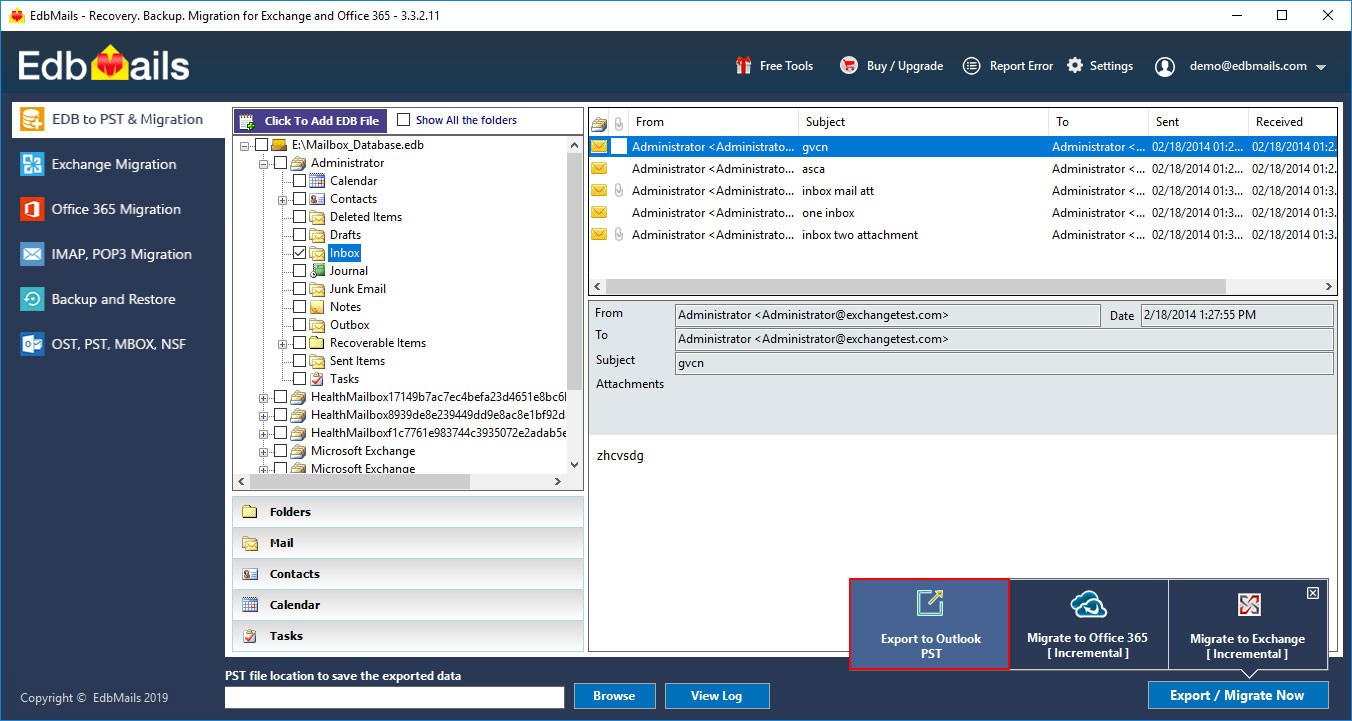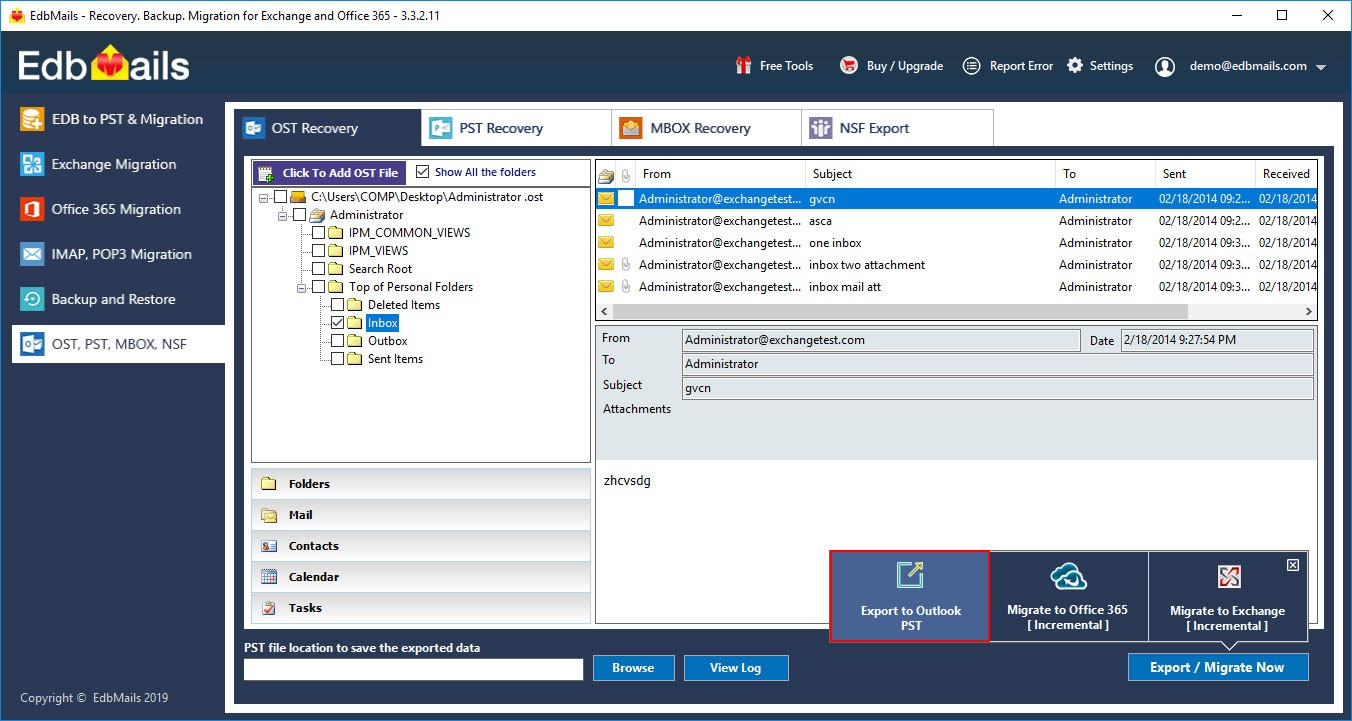How to migrate Exchange on-premise to Exchange online using EdbMails?
On-premise Exchange server refers to the presence of an Exchange server that is installed locally on the user’s environment. It may be a part of the hybrid environment where the Exchange server is present in a hybrid configuration along with Office 365, or present as a stand-alone without connection to other cloud services. There are a number of advantages why an organization would prefer working with an on-premise environment and why some others consider moving to the cloud. In this article, we shall look at some of the reasons for both and also discuss why migrating to the cloud makes sense. In one sense, on-premise environments are advantageous because you have complete control over your data. This is important for enterprises working in a secure environment. On-premise setups, on the other hand, are also difficult to maintain, necessitate manual updates, and may miss out on automatic upgrades to a newer version. End-of-life systems or legacy versions are particularly vulnerable to threats, crashes, and corruption, which can be costly for organizations. In comparison to an on-premise setup, cloud-based solutions keep receiving continuous updates and do not necessitate manual work.
Microsoft cloud services are secure and offer robust security keeping your data safe. Services such as Office 365 even offer cutting edge collaboration tools such as Microsoft Teams, OneDrive, Lync that you can use to communicate remotely. With so many advantages of cloud-based services, there is no doubt why it has become popular to consider migration to these services. You must also bear in mind that migration operations require sufficient planning and preparations depending upon your existing environment. In this article, we shall look at the reasons to migrate to Exchange online from an on-premise environment. We also introduce you to EdbMails Exchange migration tool to perform on-premise to Exchange online migration.
What are the advantages of Exchange online over on-premise environments?
Before we get into the details of migrating to Exchange online, let's first look at the advantages of cloud-based Exchange and Office 365.
Backup and secondary servers are provided by cloud services such as Office 365 and Exchange online in the event that the primary server fails. This makes them reliable and robust in the event of a failure.
Cloud services have anti-spam, anti-malware, and anti-ransomware safeguards in place. Your data is secure and accessible 24 hours a day, seven days a week.
Updates are seamless and are released in the background automatically. You can continue working while receiving the most recent updates on the fly.
Collaboration tools like Teams, OneDrive, and SharePoint make it simple to communicate with your teams and plan remote meetings.
There is no need to maintain expensive hardware or use sophisticated backup mechanisms, which may add to the workload of IT administrators.
Gone are the days when systems could only be accessed by a single person using his username and password. File and folder sharing has become very simple with cloud-based services, and they can now be shared across multiple teams for faster access and easier editing.
Cloud-based systems are always up to date, so you don't have to worry about them becoming obsolete or outdated.
What are the challenges of Exchange on-premise to Exchange online migration?
Manual migration methods can be used to perform on-premise Exchange to Exchange online migration. However, there are some limitations to using them that we will go over here.
Manual methods require extensive knowledge on PowerShell scripts which make them unsuitable for a majority of people.
They are time-consuming and do not ensure migration consistency. As a result, your source data may not be exactly replicated in your target environment.
Downtime is a common factor that cannot be avoided. This is not considered acceptable in organizations that provide critical services 24 hours a day, seven days a week such as healthcare, financial services and so forth.
Manual migration methods, on the other hand, lack extensive migration features such as the generation of detailed log reports, incremental migration, filters to migrate selected data, and so on.
How can EdbMails solve the above problems and perform Exchange on-premise to Exchange online migration?
From the preceding discussions, it is clear that manual methods of migration are unsuitable for large mailboxes and in scenarios where data consistency is required. EdbMails Exchange migration tool can help in such situations and can effortlessly perform on-premises to Exchange online or even hybrid Exchange migrations. Let us look in detail, how you can achieve this.
EdbMails performs incremental migration, which means that there are no duplicates when you successively migrate to the same target.
The tool does not cause downtime and can handle Exchange and Office 365 throttling issues. You can continue with your normal working with the migration happening in the background. This also means that there is no tying up the system resources.
There are no PowerShell cmdlets or extensive scripting knowledge required, and even non-technical users can easily perform the migration.
EdbMails precisely replicates the source data in the target. Furthermore, because the migration is direct, it ensures complete data consistency with no loss.
You can also use filters to migrate items selectively rather than performing a full migration. For example, if you want to migrate all mail data based on a specific date, you can use the Date filter.
EdbMails supports migration from legacy Exchange versions. If you're looking for a way to migrate data from an older Exchange version to Exchange online or Office 365, EdbMails is your best bet.
You can also use the tool to perform hybrid Exchange migration, which means you can keep some data on-premises and some data in the cloud. You only need to enter your source and target account credentials, and EdbMails will handle the rest.
EdbMails is a feature-rich, low-cost and industry leading Exchange migration tool
EdbMails is your best bet if you're looking for a low-cost tool to perform Exchange migration. It can perform Exchange to Office 365, hybrid Exchange migration, on-premise to Exchange online, cross-forest and cross-domain migrations, and a wide range of other Exchange migration, backup, and recovery scenarios. EdbMails advanced algorithms speed up migration operations, and its feature set adds to the overall ease of migration. The tool offers up to 75% discounts, making it very affordable for the same features as competitors. If you want to learn more about the tool or get advice on which migration is best for you, contact EdbMails 24/7 customer support for a free personalized demo, and we will be happy to help.
Conclusion
In terms of security, ease of access, and availability, cloud-based services such as Exchange online clearly outperform their on-premise counterparts. You are not required to perform manual updates or patch security flaws on your own. There is also no need to be concerned about your systems becoming obsolete because updates are released in a timely manner. Manual migrations to Exchange online require organizations to go through the ordeal of using PowerShell scripts, which are not only unintuitive but also time-consuming. EdbMails Exchange migration tool resolves the aforementioned issues, and its direct incremental migrations are simple to perform. Furthermore, EdbMails cutting-edge features will allow you to complete quick and customized migration projects with no downtime.
We'd also like to introduce you to Sigsync, a low-cost tool that can help you automatically add Office 365 email signatures, to Exchange and Office 365 users. Email signatures are essential in today's world because they do so much more than just send your contact information. You can use email signatures to schedule meetings, promote your brand and social media channels, conduct marketing campaigns, add banners and disclaimers to your emails, and so on. Sigsync is a centralized email signature service, which means you can manage email signatures for all of your employees from a single location. If you would like to know more visit https://www.sigsync.com

